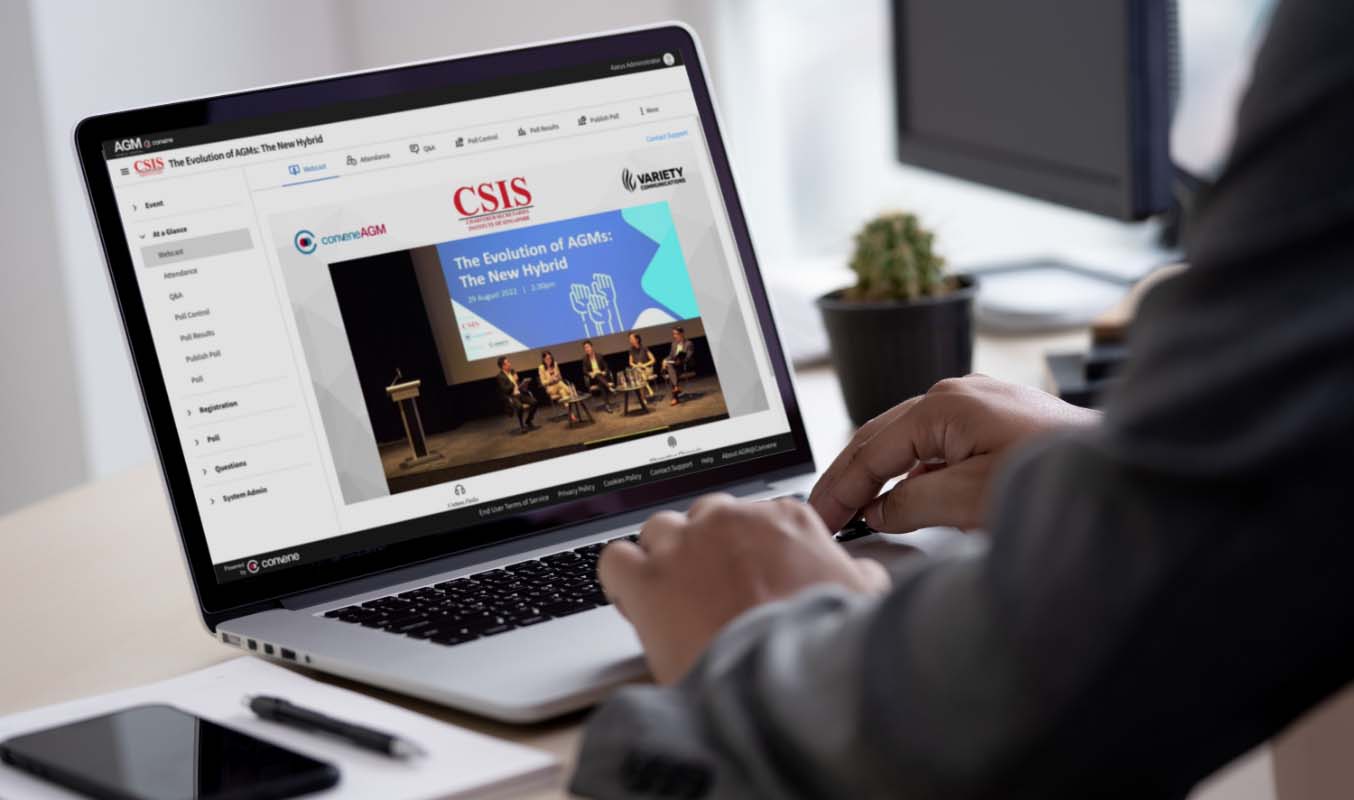The Securities Investors Association (Singapore) has strongly urged companies to hold AGMs in the hybrid mode to support effective shareholder engagement. In light of that and industry feedback, the Singapore Exchange Regulation (SGX RegCo) has mandated listed companies to provide live engagement and live voting in AGMs regardless of the meeting format effective 1 October 2022.
This 2022, as the COVID-19 measures are easing, AGMs should move forward. The new mode — hybrid — reconciles the physical and virtual components in AGMs, providing real-time webcast, live voting, and live Q&A for all attendees. In a hybrid seminar by the Chartered Secretaries Institute of Singapore (CSIS) entitled The Evolution of AGMs: The New Hybrid held on 29 August 2022, esteemed panellists talked through the new regulations of SGX RegCo, the hybrid AGM experience, and how technology can elevate virtual and hybrid general meetings.

Navigating Annual General Meetings: The Journey
The unforeseen consequences brought by the pandemic have created a journey both for companies and regulators to achieve the best practices in AGMs. Michael Tang, Vice President & Head of the Listing Policy and Product Admission at SGX RegCo, segments the journey into three parts.
First of which is ‘tackling the unknown’. When the COVID-19 cases rise to an alarming level in Singapore, regulators issued guidance on how to hold AGMs amid the situation. The Ministry of Health (MOH) advises companies to limit physical attendees and implement safe distancing measures. The Ministry of Law (MinLaw) and Ministry of Finance (MoF) advise doing alternative arrangements, such as electronic communications.
At the same time, ACRA, MAS, and SGX RegCo introduced the updated guidance on holding general meetings via electronic means but providing shareholders with their rights to watch webcast, ask questions, and vote via proxy appointment of Chairperson.
The second part of the journey is ‘adjusting to improve’. The adjustment period allows the companies, especially the Board, management, corporate secretaries, lawyers, scrutineers, and shareholders, to be familiar with the alternative arrangements — virtual and hybrid.
As the COVID-19 situation continues to improve, safety measures are relaxed and physical meetings are back. Last May, SGX RegCo issued a regulator’s column for listed companies to grant shareholders their ‘full meeting rights’ in AGMs, whether in physical, virtual, or hybrid format.
The last part is ‘preparing for the future’. The next thing to look at is how companies will respond to the latest regulations. Will companies revert to physical meetings or adopt the hybrid mode where physical and virtual attendees can participate by asking questions and voting in real time?
Tang concluded, “I believe that our companies are equipped to make the best decisions on AGMs going forward. Shareholders would provide the necessary feedback to guide them and the company secretaries and provide wise counsel to the boards on the best practices they should adopt.”
What SGX Expects from General Meetings: New Regulations
Acknowledging that companies can now conduct physical, virtual, or hybrid annual general meetings, SGX RegCo recently released a regulator’s column expecting all issuers to grant shareholders the full meeting experience regardless of the AGM format. These include their rights to ask questions, cast votes, and appoint proxies.
“Companies must use real-time remote electronic voting and communications. The live engagement and live voting are aimed to ensure full and substantive participation of shareholders at general meetings,” Tang emphasised.
Hybrid annual general meetings can escalate shareholder participation wherever they are. Teo La-Mei, Group Legal Counsel & Company Secretary of Wilmar International Ltd, supported, “I think it’s a reasonable expectation of SGX to require live engagement and live voting because it’s only fair for shareholders to interact with the company. As AGMs are only held once a year, we should make these as inclusive as possible, having both physical and virtual.”
The Role of Company Secretaries in AGMs

As a custodian of governance, company secretaries are expected to uphold compliance even on annual general meeting matters, such as what meeting format and solution to adopt.
Company secretaries must be able to assess AGM solutions and vendors and see what really fits their needs. They must look for a platform that is secure to ensure there is no double counting of votes or no unauthorised user accessing the meeting proceedings.
Moreover, understanding how general meetings will be conducted can help them evaluate the best solution in terms of structure, costs, and support. As Raymond Lam, Chairman of CSIS, said, “For you and your board to make an informed decision, know the processes, requirements, and equipment you need to hold the meeting as smoothly as possible. You should know the technology before the technology can help you.”
Recommending the best format for the company’s AGM is also a responsibility of the company secretary. The best way to go about that is to look at the shareholder base and investors. Are there overseas investors? “Choose which format has the better shareholder engagement. With this factor in mind, you can come to a landing on what appropriate meeting type you can hold,” Lam stated.
The Hybrid AGM Experience
The big question now is: will hybrid be the new normal?
In 2020, there were a lot of criticisms on virtual AGMs as static, allowing little shareholder engagement. In 2021, real-time electronic webcasts and communications are set to induce shareholder interactions. This 2022, more calls have been received on better shareholder engagement, thus a shift to the hybrid format.
Hybrid AGMs allow for real-time interaction among virtual and physical directors and shareholders. Anyone can submit questions wherever they are. Unlike in physical AGMs where participants have to line up before asking the question, hybrid AGMs allow moderation of questions through the AGM solution.
Questions with similar themes can be grouped together to form discussions, and irrelevant questions can be easily filtered. This is also more inclusive as attendees from online and onsite are given equal opportunities to ask the Chair and Board. The best practice is to always respond to relevant and substantive questions.
Voting on resolutions can also be instantly done in hybrid AGMs. Shareholders can opt to vote on each resolution or vote on all resolutions in one click. Through a hybrid AGM platform, shareholders can also vote anytime throughout the meeting and can also change their votes before finalising.
What hybrid AGMs have that cannot be replicated in virtual meetings is the benefit of personal engagement through physical interaction. Some shareholders and investors would turn up in the physical venue to see the Board, and even engage with them after the meeting.
To answer the big question, Tang highlighted, “There’s no specific mandate right now on [hybrid AGMs] but we are watching the development and listening to the stakeholders’ feedback. The fundamentals need to be there: live voting and live Q&A, but it really depends on which meeting suits your company.”
Leveraging Technology for Electronic General Meetings

Similar to any implementation of technology across the company, company secretaries and the Board must be able to assess what solution best fits their needs, and with AGMs, what the shareholder prefers for better interaction.
Technology is needed for both the virtual and hybrid general meetings, thus an AGM platform can help in digitalising the process from preparation to post-AGM while ensuring organic engagement. ConveneAGM is an end-to-end digital AGM solution designed to support all AGM formats with real-time electronic features.
Taking pride in its real-time webcasts, live voting, and live Q&A features, ConveneAGM has supported over 700 general meetings to hold best-practice digital AGMs. Yap Jia Rern, Head of Azeus’ ConveneAGM, mentioned that 20-30% of the SGX issuers have adopted live voting and live Q&A even before the regulations come into effect. This means that more companies are now looking into accommodating shareholders and investors and engaging with them.
Yap concluded, “The focus of digital AGMs is not really on process automation. It’s about the transformation of mindset of how we can bring this entire thing digitally to shareholders. Whether they are joining us physically or virtually, they will have the exact same rights and experience as though they are with us physically.”
ConveneAGM allows for a real-time webcast across all platforms and devices, wherever the participants are. Everything is digitalised and can be done on a mobile device or computer, so shareholders only need to scan a QR code or log in to enter the meeting.
The same goes for voting on resolutions and asking questions, which be done digitally for virtual and even physical participants. Live voting allows shareholders to cast votes instantly on each resolution or on all resolutions throughout the meeting. Instant tabulation of results is also supported, providing voting accuracy and accountability. ConveneAGM offers Live Q&A where shareholders can ask via in-person, textual, or video in hybrid general meetings.
Talk to us today to know how ConveneAGM can help you conduct physical, virtual or hybrid AGMs compliant with SGX regulations.
Audrey is a Content Marketing Specialist at Convene, in charge of managing the production of quality content on the company’s website. A communication major keen on marketing, Audrey has been constantly seeking approaches to create tailored content—may it be about governance, digitalization, boards, or meetings—fit for the stakeholders. When not strategizing on the next ebook to produce, Audrey finds solitude in reading make-you-ugly-cry novels and listening to self-improvement podcasts.




